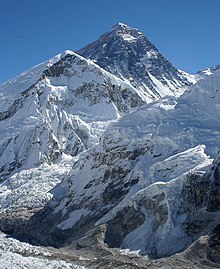2006 Philippine Mount Everest expedition
The 2006 Philippine Mount Everest expedition was the quest for the first Filipino's to climb Mount Everest, and to put the Philippine flag on top of the mountain.[1]
Background[edit]
The expedition, consisting of Filipino triathlete Leo Oración and Erwin Emata, was backed by Philippine television network ABS-CBN; Romeo Garduce, who was climbing at the same time, was sponsored by rival GMA-7.[2] Despite having rival sponsors, both teams maintained that it was not a race to the top of Mount Everest.[3] They made their ascent via the South Col route.[4] A third Filipino, Dale Abenojar, climbed independently, using the North Col route.[4][5]
Expedition[edit]
On May 13, 2006, Oración left Base Camp, and proceeded up the mountain. He reached the summit of Everest on May 17 at 3:30 pm NPT.[6][7] Upon reaching the top, Oración radioed, "The Philippine Eagle has landed."[7] His statement is based on Neil Armstrong's message "The Eagle has landed" when the Apollo 11 Lunar Module, nicknamed the "Eagle", landed on the moon.[8] The following day, Emata officially became the second Filipino to climb Mount Everest when he reached the summit at 5:34 am NPT.[9][3] The following day, Garduce reached the summit at 11:20 am NPT.[10]
Controversy[edit]
According to a press statement by Dale Abenojar's wife Liza, her husband actually reached the summit of Mount Everest on May 15, two days before Oración, but his attempt was undocumented.[5] After nearly a month, Everest chronicler Elizabeth Hawley listed Abenojar as first the Filipino summiter on her Himalayan Database.[11][12]
Reception[edit]
The ascent was celebrated in the Philippines, appearing on the front page of several Filipino newspapers.[9] Then-President Gloria Macapagal-Arroyo called it "a mark of Filipino excellence, perseverance and courage in braving the hard trek of nation-building."[13] Team leader Regie Pablo compared it to "putting a Filipino on the Moon."[13]
References[edit]
- ^ "Filipino Everest climbers encourage Oro climbers to pursue dreams". Philippine Information Agency. Cagayan de Oro. 4 July 2006. Retrieved 16 February 2013.
- ^ Romero, Paolo; Villar, Joey (May 18, 2006). "Tri-athlete Leo Oracion Conquers Mt. Everest". Philippine Headline News Online. Manila. Retrieved 16 February 2013.
- ^ a b Gulle, Jimbo; Arce, Gerald Peter (May 19, 2006). "Second Filipino conquers Everest". The Manila Times. p. 1. Retrieved 19 February 2013.
- ^ a b "Mountaineer Abenojar recovering from frostbite in Kathmandu". GMA News. May 24, 2006. Retrieved 19 February 2013.
- ^ a b Villar, Joey (May 22, 2006). "Now, who's really first on Everest?". Philippine Headline News Online. Manila. Retrieved 19 February 2013.
- ^ "Mountaineer Leo Oracion reaches Mt. Everest summit". GMA News. May 17, 2006. Retrieved 19 February 2013.
- ^ a b Papa, Alcuin (May 18, 2006). "Pinoy on top of the world". Philippine Daily Inquirer. p. 1. Retrieved 16 February 2013.
- ^ Jones, Eric M. (1995). "The First Lunar Landing – Corrected Transcript and Commentary". NASA. Retrieved 16 February 2013.
- ^ a b Calipayan, Mitchelle P. (May 18, 2006). "Celebrations as 2nd Filipino reaches top of Mt. Everest". Manila Bulletin. Retrieved 16 February 2013.
- ^ "Garduce on top of the world". GMA News. May 19, 2006. Retrieved 19 February 2013.
- ^ Papa, Alcuin (June 15, 2006). "Chronicler says Abenojar first on Everest summit". Philippine Daily Inquirer. Retrieved 19 February 2013.
- ^ Hawley, Elizabeth. "Himalayan Database Expedition Archives of Elizabeth Hawley". Retrieved 19 February 2013.
- ^ a b Papa, Alcuin (May 19, 2006). "Second Filipino Conquers Everest". Philippine Daily Inquirer. p. 21. Retrieved 16 February 2013.


